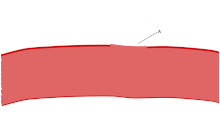
Back Bloedplaatjie Afrikaans Plaqueta AN صفيحة دموية Arabic Trombositlər Azerbaijani Трамбацыты Byelorussian Тромбоцит Bulgarian प्लेटलेट Bihari অণুচক্রিকা Bengali/Bangla Trombociti BS Plaqueta Catalan
| Platelets | |
|---|---|
 Image from a light microscope (500 ×) from a Giemsa-stained peripheral blood smear showing platelets (small purple dots) surrounded by red blood cells (large gray circular structures) | |
| Details | |
| Precursor | Megakaryocytes |
| Function | Formation of blood clots; prevention of bleeding |
| Identifiers | |
| Latin | thrombocytus |
| MeSH | D001792 |
| FMA | 62851 |
| Anatomical terms of microanatomy | |
Platelets or thrombocytes (from Ancient Greek θρόμβος (thrómbos) 'clot' and κύτος (kútos) 'cell') are a blood component whose function (along with the coagulation factors) is to react to bleeding from blood vessel injury by clumping, thereby initiating a blood clot.[1] Platelets have no cell nucleus; they are fragments of cytoplasm derived from the megakaryocytes[2] of the bone marrow or lung,[3] which then enter the circulation. Platelets are found only in mammals, whereas in other vertebrates (e.g. birds, amphibians), thrombocytes circulate as intact mononuclear cells.[4]: 3

One major function of platelets is to contribute to hemostasis: the process of stopping bleeding at the site of interrupted endothelium. They gather at the site and, unless the interruption is physically too large, they plug the hole. First, platelets attach to substances outside the interrupted endothelium: adhesion. Second, they change shape, turn on receptors and secrete chemical messengers: activation. Third, they connect to each other through receptor bridges: aggregation.[5] Formation of this platelet plug (primary hemostasis) is associated with activation of the coagulation cascade, with resultant fibrin deposition and linking (secondary hemostasis). These processes may overlap: the spectrum is from a predominantly platelet plug, or "white clot" to a predominantly fibrin, or "red clot" or the more typical mixture. Berridge adds retraction and platelet inhibition as fourth and fifth steps,[6] while others would add a sixth step, wound repair.[citation needed] Platelets participate in both innate[7] and adaptive[8] intravascular immune responses.
In addition to facilitating the clotting process, platelets contain cytokines and growth factors which can promote wound healing and regeneration of damaged tissues.[9][10]
- ^ Laki K (December 1972). "Our ancient heritage in blood clotting and some of its consequences". Annals of the New York Academy of Sciences. 202 (1): 297–307. Bibcode:1972NYASA.202..297L. doi:10.1111/j.1749-6632.1972.tb16342.x. PMID 4508929. S2CID 45051688.
- ^ Machlus KR, Thon JN, Italiano JE (April 2014). "Interpreting the developmental dance of the megakaryocyte: a review of the cellular and molecular processes mediating platelet formation". British Journal of Haematology. 165 (2): 227–236. doi:10.1111/bjh.12758. PMID 24499183. S2CID 42595581.
- ^ Lefrançais, Emma; Ortiz-Muñoz, Guadalupe; Caudrillier, Axelle; Mallavia, Beñat; Liu, Fengchun; Sayah, David M.; Thornton, Emily E.; Headley, Mark B.; David, Tovo; Coughlin, Shaun R.; Krummel, Matthew F. (April 2017). "The lung is a site of platelet biogenesis and a reservoir for haematopoietic progenitors". Nature. 544 (7648): 105–9. Bibcode:2017Natur.544..105L. doi:10.1038/nature21706. ISSN 1476-4687. PMC 5663284. PMID 28329764.
- ^ Cite error: The named reference
Michelsonwas invoked but never defined (see the help page). - ^ Yip J, Shen Y, Berndt MC, Andrews RK (February 2005). "Primary platelet adhesion receptors". IUBMB Life. 57 (2): 103–8. doi:10.1080/15216540500078962. PMID 16036569. S2CID 12054259.
- ^ Berridge, Michael J. (1 October 2014). "Module 11: Cell Stress, Inflammatory Responses and Cell Death" (PDF). Cell Signalling Biology. Vol. 6. Portland Press. pp. 11-1–11-30. doi:10.1042/csb0001011 (inactive 1 November 2024).
{{cite book}}: CS1 maint: DOI inactive as of November 2024 (link)
- ^ Gaertner F, Massberg S (December 2016). "Blood coagulation in immunothrombosis-At the frontline of intravascular immunity". Seminars in Immunology. 28 (6): 561–9. doi:10.1016/j.smim.2016.10.010. PMID 27866916.
- ^ Hampton T (April 2018). "Platelets' Role in Adaptive Immunity May Contribute to Sepsis and Shock". JAMA. 319 (13): 1311–2. doi:10.1001/jama.2017.12859. PMID 29614158.
- ^ Cecerska-Heryć E, Goszka M, Dołęgowska B (2022). "Applications of the regenerative capacity of platelets in modern medicine". Cytokine & Growth Factor Reviews. 64: 84–94. doi:10.1016/j.cytogfr.2021.11.003. PMID 34924312.
- ^ Xu J, Gou L, Qiu S (2020). "Platelet-rich plasma and regenerative dentistry". Australian Dental Journal. 65 (2): 131–142. doi:10.1111/adj.12754. PMC 7384010. PMID 32145082.